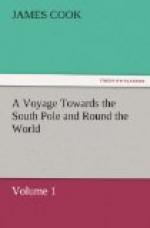We found here five different kinds of ducks, some of which I do not recollect to have any where seen before. The largest are as big as a Muscovy duck, with a very beautiful variegated plumage, on which account we called it the Painted Duck; both male and female have a large white spot on each wing; the head and neck of the latter is white, but all the other feathers as well as those on the head and neck of the drake are of a dark variegated colour. The second sort have a brown plumage, with bright green feathers in their wings, and are about the size of an English tame duck. The third sort is the blue-grey duck, before mentioned, or the whistling duck, as some called them, from the whistling noise they made. What is most remarkable in these is, that the end of their beaks is soft, and of a skinny, or more properly, cartilaginous substance. The fourth sort is something bigger than a teal, and all black except the drake, which has some white feathers in his wing. There are but few of this sort, and we saw them no where but in the river at the head of the bay. The last sort is a good deal like a teal, and very common, I am told, in England. The other fowls, whether belonging to the sea and land, are the same that are to be found in common in other parts of this country, except the blue peterel before-mentioned, and the water or wood-hens. These last, although they are numerous enough here, are so scarce in other parts, that I never saw but one. The reason may be, that, as they cannot fly, they inhabit the skirts of the woods, and feed on the sea-beach, and are so very tame or foolish, as to stand and stare at us till we knocked them down with a stick. The natives may have, in a manner, wholly destroyed them. They are a sort of rail, about the size and a good deal like a common dunghill hen; most of them are of a dirty black or dark-brown colour, and eat very well in a pye or fricassee. Among the small birds I must not omit to particularize the wattle-bird, poy-bird, and fan-tail, on account of their singularity, especially as I find they are not mentioned in the narrative of my former voyage.
The wattle-bird, so called, because it has two wattles under its beak as large as those of a small dunghill-cock, is larger, particularly in length, than an English black-bird. Its bill is short and thick, and its feathers of a dark lead colour; the colour of its wattles is a dull yellow, almost an orange colour.




